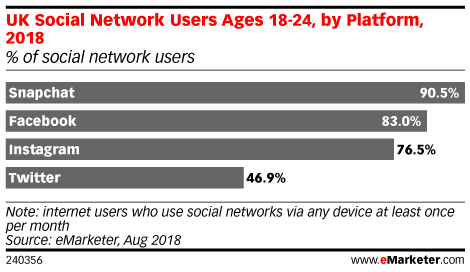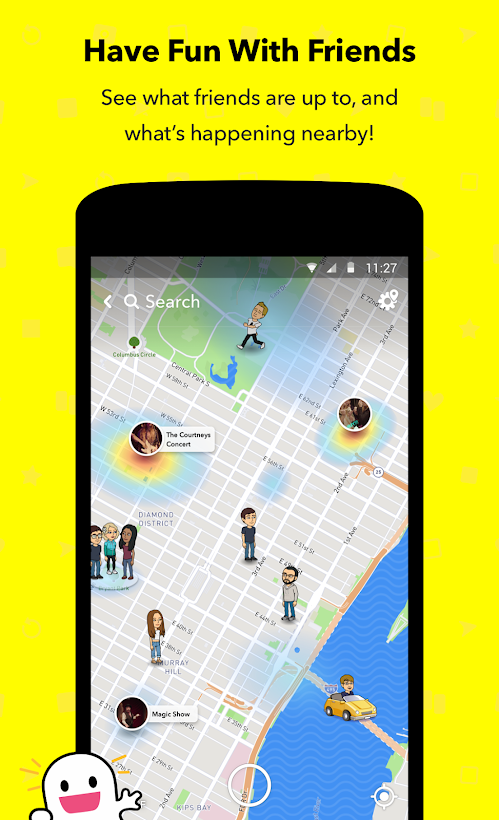Snapchat is now the most popular social media platform with the UK-based youth of 18-24 year olds. Snapchat’s user base of young adults is set to overtake Facebook’s within 2018 – and this poses a problem for Mark Zuckerberg and co.

Snapchat is set to become more popular than Facebook with youth and young adults in the UK before 2018 is out, according to eMarketer’s latest forecast on social network usage.
eMarketer has found that the number of Snapchat users between 18-24 is reaching 5 million in 2018, whereas Facebook is on 4.5 million. This is down 1.8% from the previous year.
Snap, the parent firm of Snapchat, recently documented a 2% fall in daily active users, but the growth in users in the youth category is good news for the company.
The 2% dip, which is the first since the company formed in 2011, came in Q2 of 2018. This meant the daily user count came from 191 million to 188 million in the previous quarter, which led to a $353m loss for that same period.
Instagram will be at 4.2 million users in this demographic. While it has a growing youthful user base, Snapchat is still expected to exceed Instagram. 2.6 million 18-24 year olds will be on Twitter in comparison.
The total UK-based Snapchat users in the UK is set to hit 16.2 million in 2018, with the youth taking up 31% of this userbase.
Last year, Snapchat managed to overtake Facebook among the 12-17 year old demographic. With Facebook, users will rise by 2% to 32.7 million, but this stems from older age groups.

Facebook faces a problem of managing to attract younger users, while platforms such as Snapchat manage to easily attract the 18-24 year old demographics.
Bill Fisher, an eMarketer Senior Analysts, said:
“These so-called Facebook-nevers are eating into Facebook’s user growth significantly. While the media giant’s Instagram purchase looks to have been a shrewd move in as much that it’s picking up that young user base, it’s struggling to hold onto the coattails of Snapchat among these cohorts.”
The concept of the Facebook-never is an interesting one, as it sounds almost absurd that someone could not be on Facebook, but also for someone young to not be on the biggest social media platform on the planet.
There are many reasons why today’s teenagers do not want to be found on Facebook, and have no interest in signing up to the platform.

Why is Snapchat an attractive proposition to the youth instead of Facebook?
The youth has changed
When the internet exploded, along with social media, all these networks were in their infancy. And everything that was novel about them seemed life-altering and fun and engaging.
However times have changed and so have attitudes to the internet. While sharing your every move to the internet seemed like fun back in 2005, in 2018 it is almost considered egotistical.
Back in the early days of Facebook, it was all teenagers exploring a new social network. Engaging with their friends updates and photos. But then their parents joined, and then their grandparents joined, and suddenly it’s not so cool anymore. So the demographics shift. The young switch to other platforms. Twitter, Instagram, Vine, Tumblr, Snapchat. They try them all and see what fits best. And Snapchat is the most recent “big” social platform, and one that resonates particularly well with the latest Generation Z.
Gen Z has joined the internet after millenials had already put their entire lives online and then realised, maybe that wasn’t a good idea. Now online security and privacy is all the rage, Gen Z knows this. They don’t want their lives documented like the wave before them. Which leads onto…
Privacy
While nothing is private online, Facebook and Snapchat have very different ways of interacting with other people and how you portray your life online.
In fact in some ways, you could say that Snapchat is a creation directly stemming from everything that people had come to hate about Facebook after it took over the daily lives of millions.
Facebook is centred around information, photos, updates, all being public. You share one photo to everyone you know. You share your thoughts or status updates to your friends list. They publically like, share, comment, whatever.
Snapchat is, at it’s heart, a messaging app. But it’s not simple text, it’s photos and images that you can customise. It started off as a 1 to 1 chat app that had to take place via photos, but now it has text chat and group chats and public stories and everything else. It’s expanded just in the same way Facebook did.
The key difference is almost everything you do on Snapchat is private. Other than posting a story. Even your story disappears after 24 hours never to be seen again. Your messages disappear. The photos you send to others disappear.
And after the Cambridge Analytica scandal, Facebook’s public image has dropped significantly. Even if it does make some heart-warming adverts to try and reverse this.
Mobile-first
10 or even 5 years ago, smartphones weren’t something that was capable of doing every single online task you can imagine.
5 years ago you would maybe check Facebook on your phone. You might do the odd bit of browsing. But now many people choose to do everything on their phone, and don’t even need to get their laptop out, or boot up their PC.
And the same goes for the youth. People who are turning 18 now in 2018 haven’t really experienced a life where they need a laptop for menial online tasks.
5 years ago they would have been 13, which is arguably around the time many people would get a phone. Maybe they would get a first phone at 9/10/11 (this all comes down to personal opinion) once they reach high school, but we all know they want good phones with data plans to watch videos and get online soon enough.
Point being, by the time they were of the age to warrant owning a smartphone and could go online with constant parent supervision, smartphones and fast WiFi already existed everywhere. 10 years ago, Facebook was accessed via laptops or PCs mostly.
Facebook launched in 2004, and 2006 was when it was open to everyone over the age of 13. The first iPhone came about in 2007, which arguably came out before mass-smartphone adoption. The first Android phone came from HTC in 2008.
So in 2006 when everyone is jumping aboard the Facebook train, you are going to be sitting in front of your computer. Even up to around 2010, 2011, 2012. Sitting in front of a computer on Facebook would arguably be the better experience.
Gen Z and millenials grew up with this technology, and want a mobile-first experience. Platforms such as Snapchat and Instagram offer that – built from the ground up with mobile devices in mind. Facebook was built for the web, and has slowly become a bloated mess that attempted to do everything and anything – and it ended up being a poor experience on mobiles. Again, an opinion, but compared to the initially stripped-back experience of Snapchat it’s hard to argue against).
Engagement
We have all heard about the anxieties people suffer from when it comes to getting likes or other engagement on their posts. People taking ridiculous photos and pouring hours into taking just the right photo just so they can get some likes on Instagram or Facebook.
Snapchat doesn’t have that. Put up a photo and no one likes it? You don’t know, nobody knows. You just see who views your story and that is it. No public shaming or anxiety related to getting good “numbers” on your latest photo. You can share as much as you want and no one will criticise you publically, and there’s no way in telling how popular your post is in comparison to your friends.
It’s “cool” and fun
At the end of the day, once something becomes cool, it’s cool. And at some point, it will falter. Just like Facebook has and did.
Snapchat was cool because it was new, it was different, and it ticked all the right boxes.It has funny photo filters that keep users coming back. It knew how to engage with the youth who are tech-savvy and love trying out new things. Facebook has since copied virtually every unique aspect of Snapchat, from disappearing messages to stories to photo filters and so on.
But at the end of the day, it only really made headway once your friends got it. Most platforms only expand if friends tell friends to get it. So once it established it was the place to be, it was a matter of time before everyone of that age group was on board.
No doubt in a few years time Snapchat will have made such a name for itself that older demographics will come along and come on the platform and start sending their children snapchats and watching their stories.
And Snapchat has already faltered once or twice. After a fairly poorly received update that changed how the app was laid out (much to the anger of a fairly vocal fanbase), Kylie Jenner tweeted “does anyone else not open Snapchat any more?” For the uninitiated, she is a fairly big deal with this demographic. And just this tweet alone managed to wipe $1.3billion off of the company value. If Kylie Jenner doesn’t think it’s cool, then you can bet her fanbase will begin to think the same. However, Snapchat has come back from this.
But maybe another platform will come along that is radically different, or does something that appeals to the next wave of youth. There’s no telling what they may be.
Or Snapchat could hold onto its title of the social network for the youth. After all, social media is still in its infancy and we only have a limited number of social networks to judge this on. Friendster, Myspace and Bebo to name a few.
Everyone expected Facebook to go the same way but it seems to be the first platform that truly became too big to fail – but at one point you’d have claimed that was Myspace.
But the older demographics (or the so-called “silver-surfers”) could come and crash the Snapchat party at some point soon, and force the kids elsewhere. Until then, Snapchat is the place to be for any marketing where your audience is in any way young.
Even if your brand appeals to older demographics, these statistics demonstrate just how important and overlooked Snapchat can be as a marketing channel. Most people just think of Twitter, Facebook, Instagram and maybe LinkedIn – but if Snapchat can hold its grown with this demographic, it could become the next Facebook. At which point your brand being active and popular on the platform could be invaluable.
So how else can you make the most of social media? There are many benefits of Facebook Ads for business.
Paid social advertising, or paid search? Paid social gives businesses a top opportunity to get in front of potential customers. Social media has a lot of opportunities for businesses to grow.


